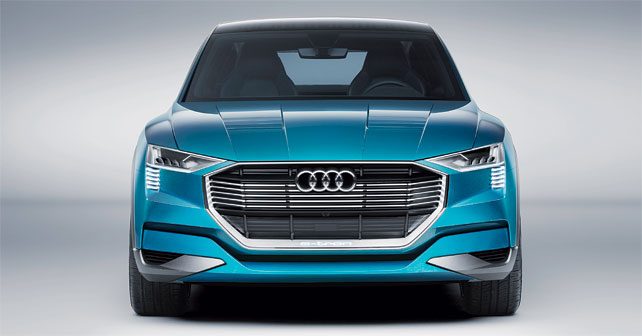
Silicon Valley automaker, Tesla Motors, may soon face some heated competition – the Audi e-tron Quattro concept and Porsche Mission E appear to herald EV’s that will comfortably cover 500-kilometres non-stop.
With the Model S, Tesla dominates the electric luxury car segment. But with no competitors, its position is relatively unchallenged. But, soon, things could change. In fact, at the Frankfurt Motor Show that concluded recently, Audi and Porsche both presented electric vehicle concepts that claim to overcome the psychological threshold of a 500-kilometre range between two charges. But the two cars are very different. The Audi e-tron Quattro is a concept SUV, while the Porsche Mission E is a four-door sports car.
Both, however, point to the solutions that may be adopted by mainstream manufacturers in their quest to offer a larger number of EV’s and plug-ins. The current Volkswagen crisis notwithstanding, the e-tron Quattro is expected to be in showrooms by 2018. It’ll be equipped with three electric motors (two on the rear and one in the front) for a total power output of 430 horsepower (500hp and 800Nm in over-boost). With a top speed of 210km/h (self-limited), it accelerates from zero to 100km/h in 4.6 seconds. Thanks to the thrusters on both axles, traction is integral and power distribution is controlled electronically by modulating the current that’s sent to the motors.
500 KMS ON A CHARGE
A range of more than 500-kilometres is achieved by batteries capable of storing 95kWh of energy, as well as careful work in the wind tunnel. To obtain a Cd of 0.25, Audi designers have adopted motorized flaps in the hood, on the side, and in the tail, which change the airflow around the vehicle from 80km/h onwards. Instead of exterior mirrors, there are micro cameras on the front fenders. The images are displayed on screens in the door panels. The e-tron Quattro is equipped with a double socket for charging the batteries, which offer the option of using both traditional alternating current as well as rapid direct current. With fast charging stations of 150kW, to ‘fill-up’ the batteries will take only about 50 minutes.
HIGH VOLTAGE
With the Mission E, Porsche instead assumed extra fast charging current of 800 volts, which will be able to provide an 80% charge in a quarter-of-an-hour – thus extending the range by about 400 kilometres. This standard of charging, however, is not yet available – and so the Porsche’s batteries can be charged on fast chargers of 400 volts and, of course, with a home network. They will even offer inductive load chargers that can be inserted into the floor.
REAL ‘TORPEDO’
The Porsche has a motor at the front and one behind for a total capacity of more than 600 horsepower, which catapults the Mission E from zero to 100 in 3.5 seconds – while it takes less than 12 seconds to reach 200km/h. As with Tesla and the Audi concept, the Porsche Mission E also has batteries distributed throughout the floor between the two axes. In this way the center of gravity is very low, and the distribution of mass is ideal – contributing to excellent handling on the road. This has allowed the Porsche to achieve a lap-time of less than eight minutes at the Nürburgring. And while Porsche hasn’t yet declared its plans, the Mission E is expected to go into production in the next four years.
THE STAR ISN’T SITTING STILL
Mercedes too presented a futuristic concept at Frankfurt. However, it’s not solely battery powered. The Concept IAA – short for Intelligent Aerodynamic Automobile, and a play on the initials of the Frankfurt Motor Show where it debuted – is, in fact, a plug-in hybrid. It’s 5.04-metres long, two-metres wide and only 130cms tall, and can travel up to 66-kilometres without using a drop of petrol. Thanks to very well designed aerodynamics, the radical shape shifting properties come into play at speeds over 80km/h for maximum aero-efficiency. In this way, Cd drops to only 0.19.
In terms of city cars, Daimler AG announced that the entire Smart family of cars will be offered in electric versions by 2016. The batteries will be manufactured by Daimler in Germany, while the electric motors will be produced by Renault in France. From BMW, meanwhile, an announcement regarding a third car in the ‘i’ family is expected soon.
Door mirrors have been replaced by small cameras fixed on the front fenders. The idea is to reduce aerodynamic drag (to achieve a Cd of 0.25). The objective is to reduce the consumption of electricity and increase range.
The Porsche Mission E is a 4-seater, 4-door sports car with a shell made of steel, aluminium and carbon fibre. Two electric motors, one at the front and one at the rear, generate a total output of over 600 horsepower.
This graphic of the e-tron Quattro highlights the arrangement of the three electric motors and the battery pack, which occupies virtually all the space between the axles. This concept is 4.88-metres long and is based on the second generation of Audi’s modular longitudinal platform.
The interior of the Audi concept can easily accommodate four people. All displays are OLED – those on the doors display images from the cameras mounted on the front fenders that serve as door mirrors.
The Porsche Mission E also uses OLED technology for the screens in the cockpit. A camera recognizes which screen you’re watching, and activates the corresponding menu – which you then manage with just one button.
© Riproduzione riservata





























Write your Comment